The soil is home to plants, animals, and countless microbes that can't survive without it. If the soil is unhealthy, unstable, or polluted, it will be futile to grow healthy plants. Soil can degrade over time through several means; hence it is necessary to take steps to maintain or improve its fertility.
The goal of soil conservation is to maintain fertile soil sustainably. As opposed to conventional agricultural methods, conservation tillage is gentler on the ground. It prevents soil erosion and degradation, which helps keep the soil fertile and productive.
What is Conservation Tillage?
Conservation tillage is a technique that reduces the number of times the soil is worked or the depth to which it is worked to reap economic and environmental benefits. It's also been said to refer to any method of soil preparation that results in at least 30% surface residue.
Conservation tillage requires crop residue management, which involves preserving the topsoil by carefully managing crop residue using minimal or no tillage. Thereby stimulating organic materials' microbial decomposition, emitting CO2, and promoting soil carbon sequestration.
Why are Soil Conservation Practices Essential?
The question remains: how do conservation tillage practices in agriculture benefit the soil? Conservation tillage improves certain facets of farm life. These include:
1. Improves Soil Quality
Healthy soil is a scarce commodity in a world where soil itself is a limited resource. Conservation measures, such as vertical tillage, can significantly improve soil quality. It does this by producing an increase in soil organic matter, lessening the volume of water lost to runoff, and curtailing the rate of soil erosion.
The residue in the soil, which benefits both water retention and nutrient release for plant growth, also helps reduce soil compaction. Soils in good condition and retaining water are less likely to be eroded by wind or water.
Although no-till and conservation tillage methods can aid in restoring soil health, some issues, such as compaction and erosion, can take years to undo completely. A long-term investment in conservation tillage can boost soil quality, increase organic matter, enhance filtration, and decrease soil erosion.
2. Helps retain moisture
Keeping a suitable layer of residue over the soil also helps retain moisture, reduces the rate of runoff, and stops soil from being eroded. Minimal tillage methods can speed up the decay of crop residue by encouraging more efficient microbial activity. It helps improve organic matter levels and distributes residue uniformly across the field.
When soil is not compacted, water and nutrients can seep further into the ground, where plants can use them. Therefore, water runoff and nutrient leaching are prevented. In the case of farmers who use a lot of fertilizer, this is hardly ever a problem.
3. Carbon capture and storage
Soil organic matter accumulates when crop residue is left in the field, improving the soil's ability to act as a carbon sink, especially in nutrient-deficient areas. Reduced utilization of fuel-powered machinery also results in lower CO2 emissions.
Conservation tillage affects both greenhouse gas emissions and carbon storage. Farmers that adopt climate-smart agricultural methods like conservation tillage can cash in on a "carbon farm" as an agricultural response to the problem of global warming.
Methods of Conservation Tillage
To preserve soil quality, a range of techniques are available. Some typical practices are as follows:
A) No-tillage
This is the least intense form of tillage and involves leaving the soil untouched by eliminating plowing. It is also known as zero-till, eco fallow, and slot planting. The seeds or nutrients are injected into the seedbed through tiny holes.
B) Low or minimum-tillage
To reduce the time spent tilling, processes are often combined. For instance, plowing is avoided to keep crop residue during field preparation and seeding procedures in a single pass.
C) Ridge-tillage
This practice involves merely tilling shallow ridges left behind from the previous growing season to reduce the amount of soil disturbance a plant requires. This tillage is best for low-lying fields or areas with poor drainage.
D) Stubble ridge-tillage
It is a higher form of ridge-tilling where the ground is covered by leaving a thick layer of crop residue on top of the soil before turning it over with a disk or moldboard plow. While ridge-tilling is usually very shallow, stubble ridge-tilling is a bit higher.
The Contrast between Conventional and Conservation Tillage
Conventional tillage is the standard method of preparing the soil for planting by inverting it with a tractor-pulled plow and then tilting it to level it for crop cultivation. Conversely, conservation tillage involves planting, cultivating, and harvesting crops with minimal soil disturbance.
Conservation tillage decreases plowing and keeps crop residue to conserve soil, water, and energy. Fewer CO2 and other greenhouse gas emissions, less need for heavy machinery and tools in agriculture, and lower fuel and labor expenses are just a few of the benefits.
Conservation tillage practices also demonstrate an increase in soil organic matter, lessen the volume of water lost to runoff, and curtail the rate of soil erosion. A well-developed and fully integrated conservation tillage method can help the sustainability of an agricultural system by providing many possible environmental and economic benefits.
Bottomline
Soil conservation is paramount for present and future agricultural productivity and crop yields, making it a top priority for individuals, farmers, and businesses. While the short-term benefits of soil conservation efforts may be difficult to notice, the long-term dividends are worth the effort.










No comments
Post a Comment